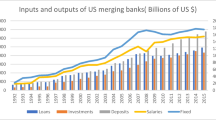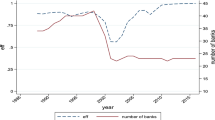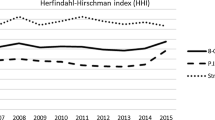Abstract
This study investigates the changes in the marginal cost, revenue, and profit efficiencies after a series of deals by US acquiring banks for the period from 1992 to 2007 using the nonparametric data envelopment analysis (DEA) method and the market reaction model. All the efficiency measures show increases in the first two deals but show significant decreases in the next two to three deals and substantial efficiency increases for the last two acquisitions. The efficiency losers are those that engage in just four mergers. Banks that undertake six to seven acquisitions recover their earlier efficiency losses to achieve a net 12.5% cumulative profit efficiency. The results of the market reaction model show that acquirers lose the most by the time they announce their third and fourth deals, 25.8% and 23.9% respectively, while targets gain the most when they acquire their fourth deal, 34.5%. The efficiency dynamics results show consistency with both the managerial hubris theory, where efficiency gains occur in early deals (first and second), and the learning theory where efficiency measures form a U-shape curve. These results show that the theories are complementary rather than contradictory. Moreover, frequent acquirers tend to be highly profitable, but most importantly they are externally attracted to finding targets with specific characteristics like a relatively small size, high percentage of operating assets, and a high cost efficiency.







Similar content being viewed by others

Notes
This paper was not initially intended to test any of the existing theories on acquisitions, but the findings show a sort of consistency with the managerial hubris and learning theories that I find favorable to present.
We also ran a Logit regression, but only present the Probit results because it provides better goodness of fit, as measured by the McFadden's Pseudo R-squared.
Cordero et al (2015) assume a trans-log production function, but they emphasize that their results are similar when assuming a Cobb–Douglas function.
References
Agrawal A, Jaffe JF, Mandelker GN (1992) The post-merger performance of acquiring firms: a re-examination of an anomaly. J Finance 47:1605–1621. https://doi.org/10.1111/j.1540-6261.1992.tb04674.x
Aktas N, Bodt ED, Roll R (2011) Serial acquirer bidding: an empirical test of the learning hypothesis. J Corp Finance 17:18–32. https://doi.org/10.1016/j.jcorpfin.2010.07.002
Aktas N, Bodt ED, Roll R (2013) Learning from repetitive acquisitions: evidence from the time between deals. J Financ Econ 108:99–117. https://doi.org/10.1016/j.jfineco.2012.10.010
Alexandridis G, Mavrovitis CF, Travlos NG (2012) How have M&As changed? Evidence from the sixth merger wave. Eur J Finance 18:663–688. https://doi.org/10.1080/1351847x.2011.628401
Al-khasawneh JA (2006) Bank efficiency dynamics and market reaction around merger announcement. Dissertation, University of New Orleans
Al-Khasawneh JA (2013) Pairwise X-efficiency combinations of merging banks: analysis of the fifth merger wave. Rev Quant Finance Account 41:1–28. https://doi.org/10.1007/s11156-012-0298-8
Al-Khasawneh JA, Essaddam N (2012) Market reaction to the merger announcements of US banks: a non-parametric X-efficiency framework. Glob Finance J 23:167–183. https://doi.org/10.1016/j.gfj.2012.10.003
Al-Khasawneh JA, Benameur K, Shariff MZ, Khiyar KA (2020) Methods of payment in US banks’ acquisition: efficiency perspectives. Appl Econ 52:1487–1501. https://doi.org/10.1080/00036846.2019.1676389
Al-Sharkas AA, Hassan MK, Lawrence S (2008) The impact of mergers and acquisitions on the efficiency of the US banking industry: further evidence. J Bus Finance Account 35:50–70. https://doi.org/10.1111/j.1468-5957.2007.02059.x
Asquith P (1983) Merger bids, uncertainty, and stockholder returns. J Financ Econ 11:51–83. https://doi.org/10.1016/0304-405x(83)90005-3
Avkiran NK (2011) Association of DEA super-efficiency estimates with financial ratios: investigating the case for Chinese banks. Omega 39:323–334. https://doi.org/10.1016/j.omega.2010.08.001
Banker RD, Charnes A, Cooper WW (1984) Some models for estimating technical and scale inefficiencies in data envelopment analysis. Manag Sci 30:1078–1092. https://doi.org/10.1287/mnsc.30.9.1078
Beccalli E, Frantz P (2016) Why are some banks recapitalized and others taken over? J Int Financ Mark Inst Money 45:79–95. https://doi.org/10.1016/j.intfin.2016.07.001
Belanès A, Ftiti Z, Regaïeg R (2015) What can we learn about Islamic banks efficiency under the subprime crisis? Evidence from GCC Region. Pac-Basin Finance J 33:81–92. https://doi.org/10.1016/j.pacfin.2015.02.012
Berger AN, Humphrey DB (1992) Megamergers in banking and the use of cost efficiency as an antitrust defense. Antitrust Bull 37:541–600. https://doi.org/10.1177/0003603x9203700302
Berger AN, Buch CM, Delong G, Deyoung R (2004) Exporting financial institutions management via foreign direct investment mergers and acquisitions. J Int Money Finance 23:333–366. https://doi.org/10.1016/j.jimonfin.2004.01.002
Bifulco R, Bretschneider S (2001) Estimating school efficiency: a comparison of methods using simulated data. Econ Educ Rev 20:417–429. https://doi.org/10.1016/s0272-7757(00)00025-x
Bifulco R, Bretschneider S (2003) Response to comment on estimating school efficiency. Econ Educ Rev 22:635–638. https://doi.org/10.1016/s0272-7757(03)00044-x
Billett MT, Qian Y (2008) Are overconfident CEOs born or made? Evidence of self-attribution bias from frequent acquirers. Manag Sci 54:1037–1051. https://doi.org/10.1287/mnsc.1070.0830
Cai J, Song MH, Walkling RA (2011) Anticipation, acquisitions, and bidder returns: industry shocks and the transfer of information across rivals. Rev Financ Stud 24:2242–2285. https://doi.org/10.1093/rfs/hhr035
Charles V, Tsolas IE, Gherman T (2018) Satisficing data envelopment analysis: a Bayesian approach for peer mining in the banking sector. Ann Oper Res 269:81–102. https://doi.org/10.1007/s10479-017-2552-x
Charnes A, Cooper W, Rhodes E (1978) Measuring the efficiency of decision making units. Eur J Oper Res 2:429–444. https://doi.org/10.1016/0377-2217(78)90138-8
Cooper WW, Seiford LM, Tone K (2006) Introduction to data envelopment analysis and its uses: with DEA-solver software and references. Springer, New York
Cordero JM, Santín D, Sicilia G (2015) Testing the accuracy of DEA estimates under endogeneity through a Monte Carlo simulation. Eur J Oper Res 244:511–518. https://doi.org/10.1016/j.ejor.2015.01.015
Das A, Ghosh S (2009) Financial deregulation and profit efficiency: a nonparametric analysis of Indian banks. J Econ Bus 61:509–528. https://doi.org/10.1016/j.jeconbus.2009.07.003
Dodd P, Warner JB (1983) On corporate governance: a study of proxy contests. J Financ Econ 11:401–438. https://doi.org/10.1016/0304-405x(83)90018-1
Dong Y, Firth M, Hou W, Yang W (2016) Evaluating the performance of Chinese commercial banks: a comparative analysis of different types of banks. Eur J Oper Res 252:280–295. https://doi.org/10.1016/j.ejor.2015.12.038
Doukas JA, Zhang W (2014) Envy-motivated merger waves. Eur Financ Manag 22:63–119. https://doi.org/10.1111/eufm.12045
Elyasiani E, Mehdian S (1992) Productive efficiency performance of minority and nonminority-owned banks: a nonparametric approach. J Bank Finance 16:933–948. https://doi.org/10.1016/0378-4266(92)90033-v
Fuller K, Netter J, Stegemoller M (2002) What do returns to acquiring firms tell us? Evidence from firms that make many acquisitions. J Finance 57:1763–1793. https://doi.org/10.1111/1540-6261.00477
Fung JKH, Pecha D (2019) The efficiency of compensation contracting in China: do better CEOs get better paid? Rev Quant Finance Account 53:749–772. https://doi.org/10.1007/s11156-018-0765-y
Haleblian J, Finkelstein S (1999) The influence of organizational acquisition experience on acquisition performance: a behavioral learning perspective. Adm Sci Q 44:29–56. https://doi.org/10.2307/2667030
Halkos GE, Matousek R, Tzeremes NG (2016) Pre-evaluating technical efficiency gains from possible mergers and acquisitions: evidence from Japanese regional banks. Rev Quant Finance Account 46:47–77. https://doi.org/10.1007/s11156-014-0461-5
Harp NL, Kim KH, Oler DK (2020) A bold move or biting off more than they can chew: examining the performance of small acquirers. Rev Quant Finance Account. https://doi.org/10.1007/s11156-020-00893-x
Hayward MLA (2002) When do firms learn from their acquisition experience? Evidence from 1990 to 1995. Strateg Manag J 23:21–39. https://doi.org/10.1002/smj.207
Hayward MLA, Hambrick DC (1997) Explaining the premiums paid for large acquisitions: evidence of CEO Hubris. Adm Sci Q 42:103–127. https://doi.org/10.2307/2393810
Isik I, Hassan M (2002) Technical, scale and allocative efficiencies of Turkish banking industry. J Bank Finance 26:719–766. https://doi.org/10.1016/s0378-4266(01)00167-4
Isik I, Hassan MK (2003) Financial deregulation and total factor productivity change: an empirical study of Turkish commercial banks. J Bank Finance 27:1455–1485. https://doi.org/10.1016/s0378-4266(02)00288-1
Ismail A (2008) Which acquirers gain more, single or multiple? Recent evidence from the USA market. Glob Finance J 19:72–84. https://doi.org/10.1016/j.gfj.2008.01.002
Loderer C, Martin K (1990) Corporate acquisitions by listed firms: the experience of a comprehensive sample. Financ Manag 19:17–33. https://doi.org/10.2307/3665607
Loughran T, Vijh AM (1997) Do long-term shareholders benefit from corporate acquisitions? J Financ 52:1765–1790. https://doi.org/10.1111/j.1540-6261.1997.tb02741.x
Malmendier U, Tate G (2008) Who makes acquisitions? CEO overconfidence and the market’s reaction. J Financ Econ 89:20–43. https://doi.org/10.1016/j.jfineco.2007.07.002
Mckee G, Kagan A (2018) Community bank structure an x-efficiency approach. Rev Quant Finance Account 51:19–41. https://doi.org/10.1007/s11156-017-0662-9
Moeller SB, Schlingemann FP, Stulz RM (2005) Wealth destruction on a massive scale? A study of acquiring-firm returns in the recent merger wave. J Finance 60:757–782. https://doi.org/10.1111/j.1540-6261.2005.00745.x
Orme C, Smith P (1996) The potential for endogeneity bias in data envelopment analysis. J Oper Res Soc 47:73–83. https://doi.org/10.1057/jors.1996.7
Prior D, Tortosa-Ausina E, García-Alcober MP, Illueca M (2019) Profit efficiency and earnings quality: evidence from the Spanish banking industry. J Prod Anal 51:153–174. https://doi.org/10.1007/s11123-019-00553-w
Rau PR, Vermaelen T (1998) Glamour, value and the post-acquisition performance of acquiring firms. J Financ Econ 49:223–253. https://doi.org/10.1016/s0304-405x(98)00023-3
Ray SC, Das A (2010) Distribution of cost and profit efficiency: evidence from Indian banking. Eur J Oper Res 201:297–307. https://doi.org/10.1016/j.ejor.2009.02.030
Ruggiero J (2005) Impact assessment of input omission on DEA. Int J Inf Technol Decis Mak 04:359–368. https://doi.org/10.1142/s021962200500160x
Sahoo BK, Mehdiloozad M, Tone K (2014) Cost, revenue and profit efficiency measurement in DEA: a directional distance function approach. Eur J Oper Res 237:921–931. https://doi.org/10.1016/j.ejor.2014.02.017
Schipper K, Thompson R (1983) Evidence on the capitalized value of merger activity for acquiring firms. J Financ Econ 11:85–119. https://doi.org/10.1016/0304-405x(83)90006-5
Schlotter M, Schwerdt G, Woessmann L (2011) Econometric methods for causal evaluation of education policies and practices: a non-technical guide. Educ Econ 19:109–137. https://doi.org/10.1080/09645292.2010.511821
Sealey CW, Lindley JT (1977) Inputs, outputs, and a theory of production and cost at depository financial institutions. J Finance 32:1251–1266. https://doi.org/10.1111/j.1540-6261.1977.tb03324.x
Shams SM, Gunasekarage A (2016) Operating performance following corporate acquisitions: does the organisational form of the target matter? J Contemp Account Econ 12:1–14. https://doi.org/10.1016/j.jcae.2016.02.001
Wang JC (2003) Merger-related cost savings in the production of bank services. SSRN Electron J. https://doi.org/10.2139/ssrn.648108
Author information
Authors and Affiliations
Corresponding author
Additional information
Publisher's Note
Springer Nature remains neutral with regard to jurisdictional claims in published maps and institutional affiliations.
Appendix 1
Rights and permissions
About this article
Cite this article
Al-Khasawneh, J.A., Sanchez, B.A. Deal-to-deal marginal efficiency dynamics of serial US banking acquirers. Rev Quant Finan Acc 57, 1283–1308 (2021). https://doi.org/10.1007/s11156-021-00978-1
Accepted:
Published:
Issue Date:
DOI: https://doi.org/10.1007/s11156-021-00978-1



